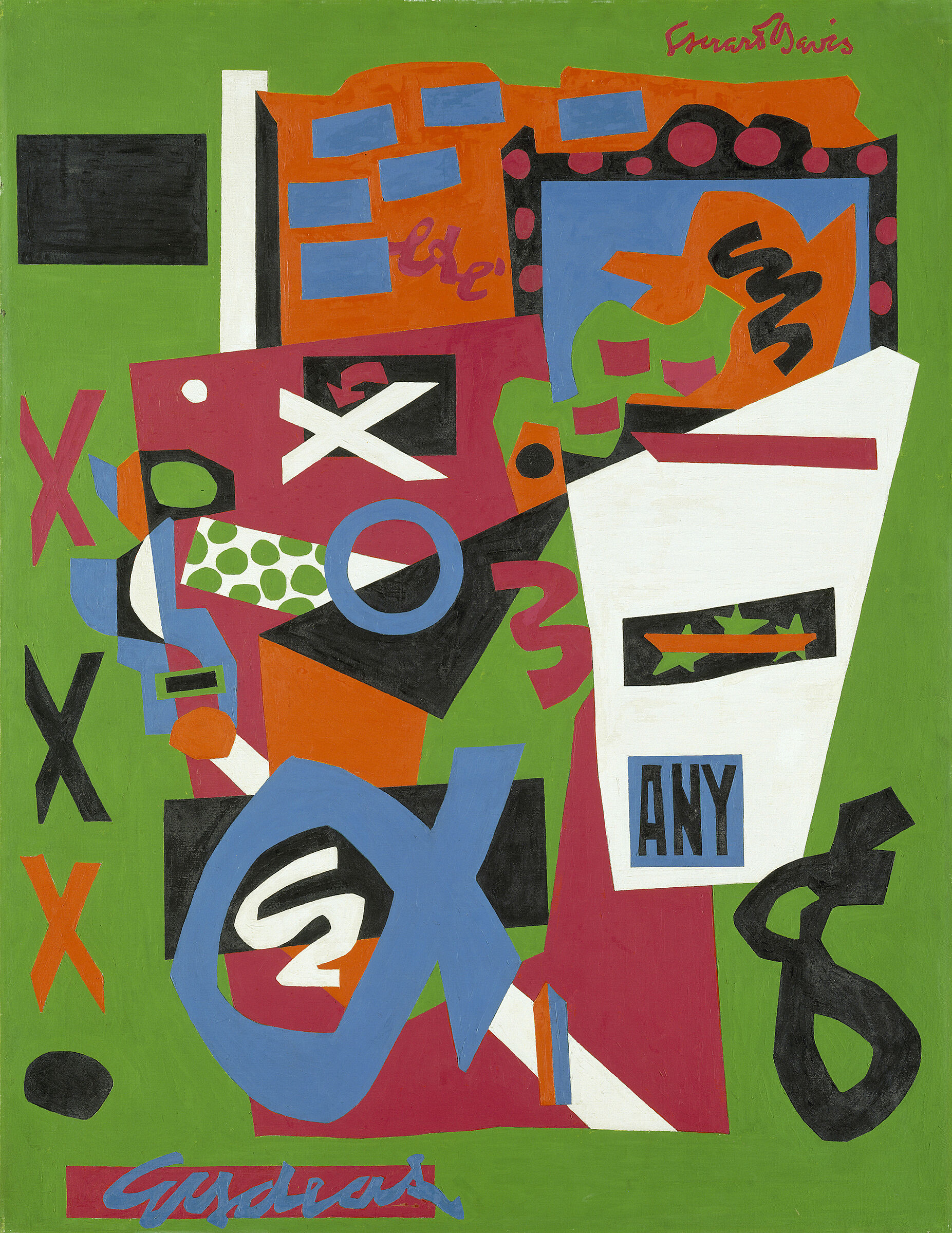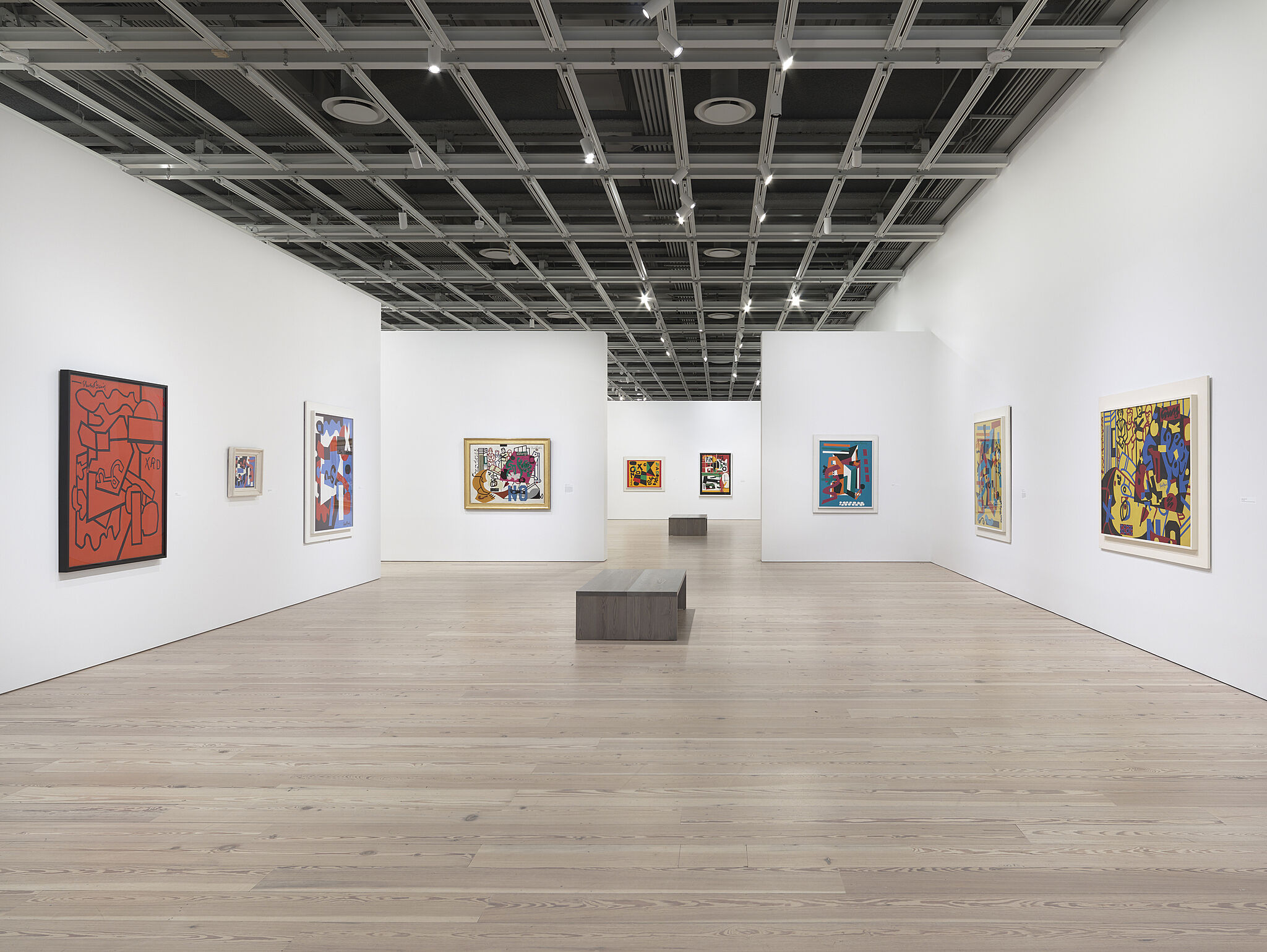Stuart Davis: In Full Swing
June 10–Sept 25, 2016
Stuart Davis (1892–1964) is one of the preeminent figures of American modernism. With a long career that stretched from the early twentieth century well into the postwar era, he brought a distinctively American accent to international modernism. Faced with the choice between realism and pure abstraction early in his career, Davis invented a vocabulary that harnessed the grammar of abstraction to the speed and simultaneity of modern America. By merging the bold, hard-edged style of advertising with the conventions of European avant-garde painting, he created an art endowed with the vitality and dynamic rhythms that he saw as uniquely modern and American. In the process, he achieved a rare synthesis: an art that is resolutely abstract, yet at the same time exudes the spirit of popular culture.
The exhibition is unusual in its focus on Davis’s mature career and on his working method of using preexisting motifs as springboards for new compositions. From 1939 on, Davis rarely painted a work that did not make reference, however hidden, to one or more of his earlier compositions. Such “appropriation” is a distinctive aspect of his mature art. This presentation will be the first major exhibition to consistently hang Davis’s later works side by side with the earlier ones that inspired them. With approximately one hundred works, from his paintings of consumer products in the early 1920s to the work left on his easel at his death in 1964, the exhibition will highlight Davis’s unique ability to transform the chaos of everyday life into a structured yet spontaneous order that communicates the wonder and joy that can be derived from the color and spatial relationships of everyday things.
Stuart Davis: In Full Swing is co-organized by Barbara Haskell, Curator, Whitney Museum of American Art, New York, and Harry Cooper, Curator and Head of Modern Art, National Gallery of Art, Washington, DC, with Sarah Humphreville, Curatorial Assistant, Whitney Museum of American Art, New York.
Stuart Davis: In Full Swing is organized by the Whitney Museum of American Art, New York, and the National Gallery of Art, Washington, DC.
In New York, the exhibition is sponsored by

Major support is provided by the Henry Luce Foundation and the Terra Foundation for American Art.
Significant support is provided by the Philip and Janice Levin Foundation and Ted and Mary Jo Shen.
Generous support is provided by Barney A. Ebsworth, Cheryl and Blair Effron, Karen and Kevin Kennedy, Arlene and Robert Kogod, Garrett and Mary Moran, and Laurie M. Tisch.
Additional support is provided by the Alturas Foundation, Jeanne Donovan Fisher, and Pitt and Barbara Hyde.
Major endowment support is also provided by the Barbara Haskell American Fellows Legacy Fund.


This exhibition is supported by an indemnity from the Federal Council on the Arts and the Humanities.
The 1950s
6
Davis's early paintings had often included words and phrases as product names and signage. In 1950, he began incorporating words into his art as independent design elements. Doing so allowed him to infuse his paintings with the bold energy and ebullience of advertising and popular culture without resorting to illusionistic realism. Sometimes the words he included referenced objects he observed in the world, as in Little Giant Still Life (1950), based on a matchbook cover advertising Champion spark plugs. In other paintings, the words refer to aesthetic concepts he was writing about in his journals. In neither case did he intend the words to be clues to a painting's meaning, which he insisted rested exclusively in the work's formal properties.
Davis's reliance on words as major design elements coincided with his introduction of a new vocabulary of expansive shapes whose increased scale heightened the impact of their color. By controlling the spatial properties of color to advance and recede, Davis ensured that the forms in his paintings visually moved forward and backward at equal speeds. The effect was of a fast-moving surface, perceived simultaneously as a single impression that seemed to push into the viewer's space with enormous force an impression one critic approvingly likened to a "good sock on the jaw."
Below is a selection of works from The 1950s.
Semé, 1953
Semé forms a “family group” with Davis’s paintings Rapt at Rappaport’s (1951–52) and Landscape with Saw (1922), which hang nearby. In addition to its title—an art historical term used to describe a grouping of shapes that cannot be divided into smaller, independent parts—the work includes a number of words related to Davis’s attitude toward subject matter and composition. “Any” refers to Davis’s theory that any subject can be used to make art, and “eydeas” is a playful conflation of “eye” and “ideas,” implying the interconnection of both elements in the act of painting.
Events
View all-

Open Studio: Weekend Member Early Admission
Saturday, October 29, 2016
9:30–10:30 am -

Insider Perspectives on Stuart Davis: In Full Swing and Human Interest: Portraits from the Whitney’s Collection
Sunday, September 25, 2016
2–3:30 pm -

Family Fun: for Families with Kids on the Autism Spectrum
Saturday, September 24, 2016
9:30–11 am -

Verbal Description and Touch Tour: Feel the Rhythm
Thursday, September 22, 2016
6–8 pm
Mobile guides
Learn more about selected works from artists and curators.
View guideExhibition Catalogue
This book pays tribute to the mature work of Stuart Davis, a distinctly American artist who adapted European modernism to reflect the sights, sounds, and rhythms of popular culture.
Beginning in 1921, a series of creative breakthroughs led Davis away from figurative painting and toward a more abstract expression of the world he inhabited. Drawing upon his admiration for Cézanne, Léger, Picasso, and Seurat, Davis developed a style that would evolve over the next four decades to become a dominant force in postwar art. His visionary responses to modern life and culture both high and low remain relevant more than 50 years after his death. Focusing on the images and motifs that became hallmarks of his career, this book features approximately 100 works—from his paintings of tobacco packages of the early 1920s, the abstract Egg Beater series, and the WPA murals of the 1930s, to the majestic works of his last two decades. The authors take a critical approach to the development of Davis's art and theory, paying special attention to the impact his earlier work had upon his later masterpieces. They also discuss Davis’s unique ability to assimilate the lessons of Cubism as well as the imagery of popular culture, the aesthetics of advertising, and the sounds and rhythms of jazz—his great musical passion. Informed by previously unpublished primary documents, the detailed chronology is, in effect, the first Davis biography. Together, these elements create a vital portrait of an artist whose works hum with intelligence and energy.
Buy now
Explore works from this exhibition
in the Whitney's collection
View 7 works
In the News
"He Made It American"
—The New York Review of Books
"An Antidote to Depression-Era Gloom"
—The Wall Street Journal
"Abstract Meets Pop Culture in Stuart Davis' Iconic Art"
—WNYC
"Stuart Davis at the Whitney"
—Front & Center at Rockefeller Center
"Stuart Davis: A Little Matisse, a Lot of Jazz, All American"
—The New York Times
"Review: Stuart Davis at the Whitney"
—WNYC
"Davis at the Whitney: Putting Some Pop in Abstract Art"
—The Wall Street Journal
"Stroke of Genius: A Peek at NYC's Summer Art Exhibits"
—The Village Voice
"In this beautifully paced show, hung by the Whitney curator Barbara Haskell, Davis’s earlier phases prove most absorbing. They detail stages of a personal ambition in step with large ideals."
—The New Yorker
"High-spirited Romp: the Best of Stuart Davis"
—New York Observer
"Davis’s musical paintings burst with musicality."
—Brooklyn Rail
"Stuart Davis: In Full Swing, New York — ‘Soul-warming’"
—Financial Times
"Showcasing his work from 1921 to his death in 1964, this exhibition allows the visitor to fully appreciate the artist’s interest in going back through his older sketches and paintings to find inspiration."
—Studio International
"Stuart Davis: In Full Swing, the well-chosen survey of more than 80 significant works now at the Whitney Museum of American Art, is reason for rejoicing."
—The Wall Street Journal
"Back to the beginning with Stuart Davis"
—The Art Newspaper
"He created art that merged European avant-garde abstraction with the energy of familiar American signs and symbols, thus setting the stage for Jasper Johns, Ed Ruscha, Barbara Kruger, and countless 'word and image' artists who followed."
—Leslie Rankow Blog
"A Bridge Between New York and Paris: on Stuart Davis at the Whitney Museum"
—The Art Newspaper
"This Davis exhibit is full of pop, sizzle, exuberance and patriotism."
—Republican American
"Upbeat and Edgy: Stuart Davis at the Whitney"
—Hyperallergic
"Stuart Davis Was a Genius of Modern Style Before Style Became a Bad Word"
—Artnet News









